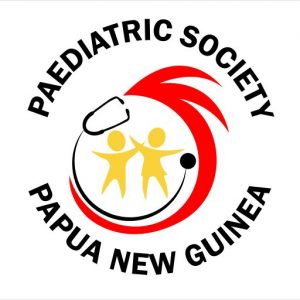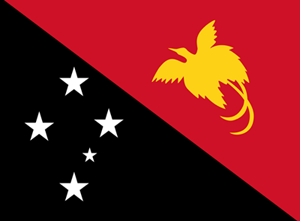Diploma of Child Health
At Port Moresby General Hospital, between 2016 and 2018, 61 children with cancer were diagnosed. The mean time of diagnosis from first symptoms was 8 months, and the mean time from presentation to diagnosis was 9 days. Compared with earlier studies from 1998-2001 there has been an increase in retinoblastoma diagnoses and a decrease in the number of children diagnosed with lymphoma. The late presentation is a concern, and messages need to get out to health workers about the signs that could indicate childhood cancer: severe pallor, a lump, swelling of the abdomen, easy bleeding and progressive malnutrition. For retinoblastoma the early signs are leukocoria (white pupillary reflex), strabismus (squint) and eye inflammation or swelling which does not resolve with antibiotics.
At Port Moresby General Hospital Children’s Emergency Department waiting times for 164 patients was assessed. A 5-tier Australasian Triage classification is used, but there is not consistency of classification between health care workers. Average overall waiting time was 119 mins; 96% of patients in category 1 (the most severe) and category 2 waited longer than specified by the Australasian Triage criteria. There is a need to use a Triage classification system that is easy to understand, such as WHO’s triage system (Emergency signs, Priority signs, or none of the above), and a need to improve staffing in the children’s emergency department, including more nurses and specialist paediatric cover to support the registrars.
In Mendi, care seeking behaviour of the parents of 100 children requiring admission with pneumonia (53), diarrhoea (43) or both (4) was assessed. 70% of the patients were infants. Many parents sought hospital treatment more than 24 hours after onset of illness despite residing within an hour of the hospital. Most parents who delayed care did so thinking that the symptoms were not serious, and waited at home for them to subside. The presence of more than one symptom of illness seemed to be a motivating factor to seek care, parents understanding that this indicates increased severity of illness. Some parents had false beliefs about the cause of diarrhoea, believing it was normal phase in child development, rather than an infection or illness.
In a randomised trial in the Port Moresby General Hospital Emergency Department, children under 2 years of age with clinical bronchiolitis were given either nebulisation with normal saline (x 3 over 4 hours) in addition to standard treatment (oxygen if SpO2<90%, antibiotics, minimal handling), or standard treatment alone. A change in Respiratory Distress Score, hypoxaemia and admission were the main outcomes. The 2 groups were similar to begin with in terms of RDS and oxygen saturation. There was a significant difference in the change in RDS at 4 hours between the 2 groups. Among the 100 that received nebulised Normal saline, the mean RDS fell by 3.41 (95% CI 3.0-3.8), whereas in the Standard group the RDS fell by only 1.96 (95% CI 1.5-2.4). P-value <0.0001. There was a significant difference in the change in SpO2 between the 2 groups. Among the 99 children who received standard therapy the SpO2 increased by 4% (95% CI 2.8-5.2) to a mean SpO2 of 87.5% at 4 hours, and among the 100 who received normal saline the SpO2 increased by 7% (6.0-7.9) to a mean SpO2 of 90.7% at 4 hours. There was a significantly higher discharge rate in those who received Normal saline. 58 of 100 (58%) were discharged, whereas only 24 of 99 (24.2%) who received Standard care were discharged (p<0.001).
Master of Medicine
A follow-up study was conducted for 81 low birth weight babies recruited from the Special Care Nursery at Port Moresby General Hospital. The mean birth weight was 1495 g, and the mean gestational age was 34 weeks, meaning these LBW babies were significantly small for gestational age, as well as being preterm. The median length of stay was 19 days, and the discharge weight was 1.54kg. There were 16 known deaths: 13 while in hospital and 3 after discharge. Many infants were lost to follow up. 39 were followed up at a median of 9 months chronological age. The majority of these babies followed up were well nourished with a weight-for-length z-score of -0.3, and most had good head growth (40th centile). 47% had some degree of gross motor developmental delay, although it is too early to be sure. 15 (38%) were admitted to the children’s ward during the period of follow-up, mostly for respiratory and gastrointestinal infections, which highlights the increased vulnerability to community acquired infections in this population.
A descriptive study was done to assess the outcomes of children exposed to HIV in the Prevention of Parent to Child Transmission Programme at the Well Baby Clinic, of Port Moresby General Hospital. 135 children were followed. All received zidovudine for the first 6 weeks of life, and 118 received nevirapine. 58 were exclusively breast fed, 25 formula fed, 40 mixed fed, and in 12 the feeding method was unascertained. 95 received isoniazid prophylactic therapy. 14 (10%) had a positive HIV-PCR test at 6-8 weeks of age. Two thirds (90/135) did not have any follow-up testing at 6 or 18 months and nearly 2/3 were lost to follow-up by 18 months (85/135). 6 were known to have died. There has been a deterioration in PPTCT and HIV services for children since the loss of funding and coordination by the CHAI PNG, leading to high rates of loss to follow up and inadequate testing being done.
50 children with multi-drug resistant TB were described at Port Moresby General Hospital. The numbers of children diagnosed from 2004 have increased each year. These children came from National Capital District, Central and Gulf Provinces, and Daru. 38 (76%) had previously undergone treatment for drug-sensitive TB, and 31 had completed this treatment. A contact source for drug-resistant TB was identified in 25 children, and in 10 children the contact was the child’s mother. The median length of illness until diagnosis was 7 months, but many children had received multiple courses of DS TB and other treatments, either complete or partial. 35 children had confirmation of rifampicin resistance on GeneXpert testing, and 15 were diagnosed on clinical grounds alone. 16 were TB culture positive, and drug resistance patterns were identified in 15 of these.
48 children with rheumatic heart disease (RHD) were involved in a longitudinal cohort study, using quantitative and qualitative methods to understand their and their family’s perceptions of their condition, and secondary prophylaxis. These children had quite severe RHD, with 31 having moderate-severe mitral regurgitation, 20 having moderate-severe aortic regurgitation, and 31 on anti-heart failure medications. There were 4 deaths in the follow-up period, including 2 sudden deaths immediately after injections of benzathine penicillin in children with severe heart failure. The deaths lead to a change in secondary prophylaxis at Port Moresby General Hospital: from predominantly benzathine penicillin to daily oral penicillin V.
In Kimbe 214 children with anaemia (median Hb 6.72 g/dL) were studied. 14 children had a history of chronic illness, including pulmonary tuberculosis (6 cases previously diagnosed), HIV, hypothyroidism and cerebral palsy (1 each). Rapid diagnostic tests for malaria were done in 213 children: 133 were negative, 33 were positive for plasmodium falciparum, 43 were mixed, and 4 were plasmodium vivax 179 children were followed up and had a repeat Hb 5 months after first presentation. The mean change in Hb for the 179 children was 4.07 (SD 2.51) g/dL. Five children died from malignancies (AML and retinoblastoma), severe malaria, HIV and severe malnutrition and meningitis. The mortality rate for severe anaemia can be low if Standard Treatment is followed and comorbidities are identified and treated.
47 children with epilepsy were studied over nearly 2 years at Port Moresby General Hospital, the median age of the children was 6.5 years. 21 (45%) had normal development, and 26 (55%) had some developmental delay. Most children had generalised tonic-clonic seizures or complex partial seizures. Over 20 months of close follow up and adjustment of medications the proportion of children with good control (less than 4 seizures per month) increased (73% at baseline and 92% good control at 20 months), and the proportion with very poor control decreased. Frequent stock-outs of phenobarbitone, lack of reliable availability of alternative anti-epileptic drugs (sodium valproate, carbamazepine, phenytoin), and financial challenges faced by parents effected the child’s seizure control. For the children with epilepsy stigma and discrimination affected the quality of their lives, but many had strong ambitions to do well in school and get good jobs in the future.

